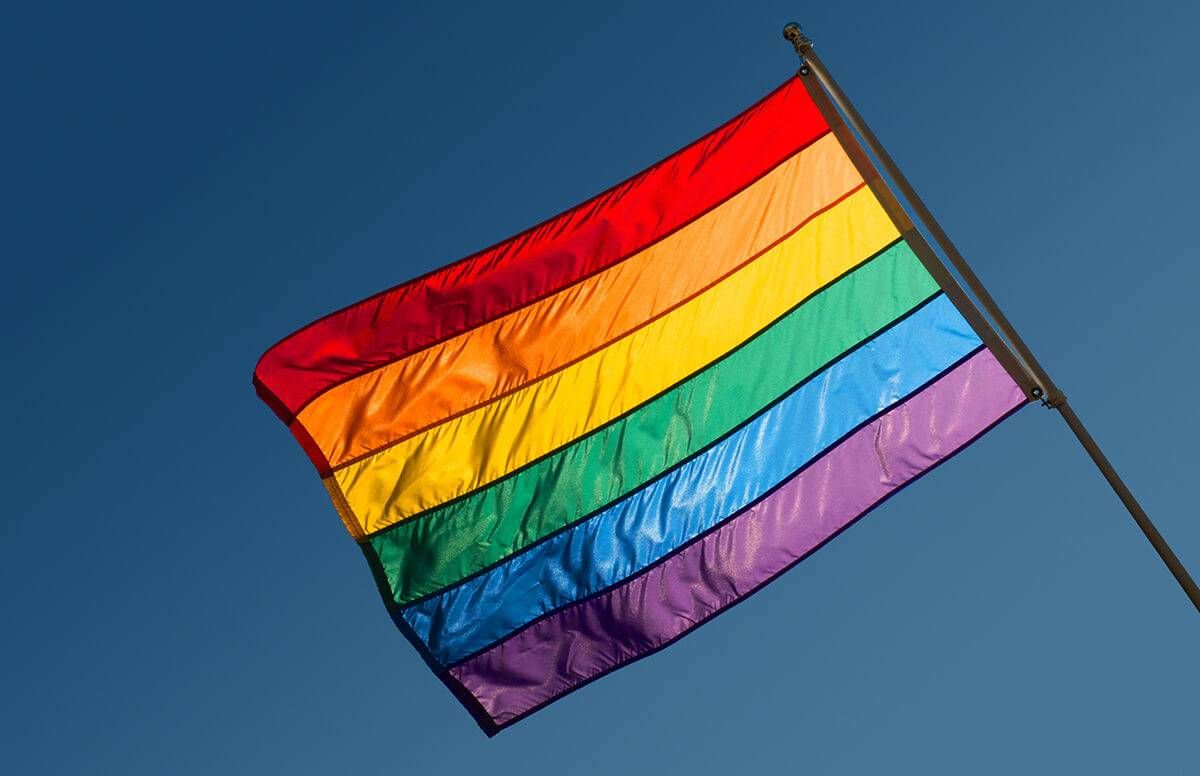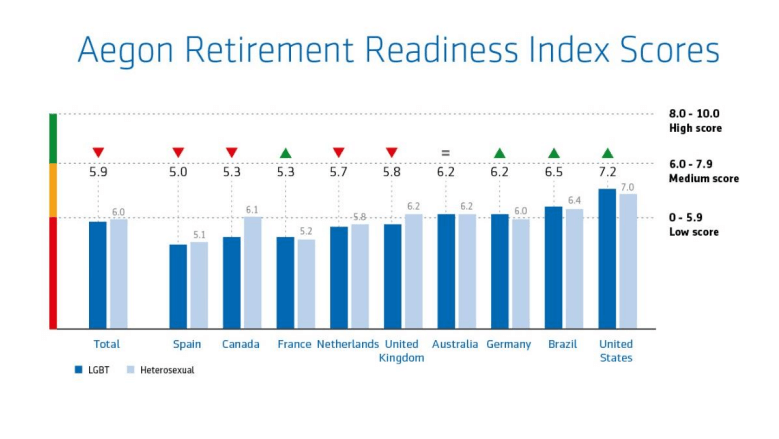LGBTQ Retirement Prospects: A Survey's Surprising Findings
Despite cautious optimism, some major challenges remain
The retirement crisis that LGBTQ older adults in America were facing in 2014 seems to be fading somewhat. What’s more, American LGBTQ workers are more prepared for retirement than those in eight other major countries. Those are the upshots from a surprising new global study by Aegon Center for Longevity and Retirement, Transamerica Center for Retirement Studies (TCRS) and Instituto de Longevidade Mongeral Aegon.

This isn’t to say the retirement picture for the 10.1 million LGBTQ Americans — including the 2.4 percent of people age 52 to 70 who identify as such — is altogether rosy.
'Cautiously Optimistic' About Retirement Prospects
But prospects are improving, said Catherine Collinson, CEO and president of TCRS, who describes herself as “cautiously optimistic” about an improving retirement scenario for today’s LGBTQ workers based on the survey.
A primary reason noted in her report, LGBT: The Retirement Preparations Amid Social Progress, is the 2015 Supreme Court ruling allowing same-sex couples to marry in all 50 states. The ruling has allowed LGBTQ couples who marry to receive survivor rights for inheritance, pension and other benefits to the same extent as heterosexuals. In a 2017 Prudential report, The LGBT Financial Experience, LGBT households with legally recognized partnerships said being married was simplifying their financial lives.
“Lots of things were different for LGBTQ people before the ruling. Fortunately, they’re becoming less different,” said Suzanne Killea, a Merrill Lynch Wealth Management adviser at the Killea Giles Team in Palo Alto, Calif.
Just before the Supreme Court ruling, a 2014 study from SAGE (Services and Advocacy for GLBT Elders) found a heavy level of worries by older LGBTQ people that they wouldn’t be able to survive in retirement, worries that were significantly higher than older Americans in general.
“Historically, LGBTs were much more likely to face financial struggles in their older years, with many retiring in poverty,” Collinson told me. “But it’s really encouraging to see that today’s workers who are LGBT appear to have a much brighter retirement outlook, employment opportunities, access to 401(k)s and other types of retirement savings. And hopefully, discrimination that occurred in the past will stay in the past.”
Is Discrimination Against the LGBTQ Community Worsening?
Sadly, however, discrimination against the LGBTQ community not only isn’t going away, it may be worsening.
In its new, fourth-annual survey measuring American attitudes toward LGBTQ people and issues, GLAAD and The Harris Poll found a “decreasing acceptance of LGBTQ people” for the first time. Only 49 percent of non-LGBTQ adults said they were “very” or “somewhat” comfortable with LGBTQ people, down sharply from 53 percent in 2017, and 55 percent of LGBTQ adults reported experiencing discrimination because of sexual orientation or gender identity, up 11 points from 2017.
Key Findings From the Retirement Preparedness Report
Some highlights from the cheerier news in the Aegon/Transamerica report:
LGBT workers in the U.S. achieved the highest retirement readiness score of all LGBT workers surveyed — 7.2 out of 10. The score for LGBT workers across all nine countries (Australia, Brazil, Canada, France, Germany, the Netherlands, Spain, the United Kingdom and the United States): 5.9.
But the U.S. score "was still a medium level of readiness,” said Collinson. “There are clearly opportunities for improvement among LGBT — and non-LGBT — people.” (U.S. workers overall scored a 6.9 for retirement readiness in an earlier Aegon/Transamerica survey, higher than workers overall in many other countries.)
LGBT workers in the United States scored slightly higher for retirement readiness than heterosexual workers here: 7.2 vs. 7.0. Collinson’s caveat: The LGBT sample skewed higher for senior, white-collar professional and managerial jobs than the overall workforce.
84 percent of LGBT workers in the U.S. feel personally responsible for making sure they have sufficient income in retirement. By contrast, only 70 percent of U.S. workers overall do. Killea told me that at her firm, LGBTQ clients “are very good at planning for retirement; they recognize there may be more variability to how life plays out for them, so they’re more apt to engage in planning.”
72 percent of LGBT workers in the U.S. feel able to understand financial matters when it comes to planning for their retirement. Just 57 percent of U.S. workers overall do.
65 percent of LGBT workers in the U.S. feel their retirement plans are well developed. For workers overall, it’s 57 percent. Added Killea: "The study also highlights that both LGBT individuals and couples should explore what 'retirement' could look like — and where, how and when they might begin to move toward that next phase."
61 percent of LGBT workers are “habitual savers” who say they always make sure they are saving for retirement. Only 37 percent of workers overall described themselves this way. “The extent to which LGBT workers in the U.S. are saving and planning for retirement is impressive,” Collinson said.
46 percent of LGBT workers in the U.S. think they are on course to achieve around three-quarters or more of their retirement income needs. That’s eight points higher than for workers overall — though, still, it’s just 46 percent, so no reason for jubilation.

Discouraging Findings for LGBT Women
The results are less encouraging for LGBT women than for LGBT men and heterosexual men, however. LGBT women average a retirement readiness score of just 5.4 globally; the score is 6.2 for LGBT men and 6.4 for heterosexual men.
One explanation: LGBT women are likely to earn much less than men in general and less than heterosexual women. “Our survey found a double whammy for lesbians: a gender pay gap and an LGBT pay gap,” said Collinson. LGBT women, the report said, have household incomes 17 percent less than heterosexual women, on average, and 27 percent less than heterosexual men, undermining their ability to save for retirement.
Tempered Enthusiasm Due to Younger Days of LGBTQ Boomers
Collinson tempers her enthusiasm about the survey results for the American LGBTQ community by noting that for many years, they lacked legal protections or the ability to get married. As a result, she said, many retired LGBTQ people are struggling financially. The legacy of LGBTQ boomers’ younger days “now shapes their lives in retirement,” her report said.
Proof: A 2017 report from SAGE and the Movement Advancement Project noted that a third of LGBT adults age 65 or older live at, or below, 200 percent of the federal poverty level. By contrast, a quarter of heterosexual older adults do.
The Aegon/Transamerica report says that currently, “LGBT people face an even greater risk of not achieving a financially secure retirement compared to heterosexuals.”
That may be changing, however, Collinson said. “The future is looking better, but I’m not ready to say we’re all caught up yet. My hypothesis is that, over time, we’ll see the retirement outlook for LGBT people track closely with the overall population,” she said.
4 Retirement Planning Tips for the LGBTQ Community:
Collinson offered these four tips to people who are LGBTQ, for a more financially secure retirement:
1. Be sure your estate planning and beneficiary designations are up to date. Review your pension benefit forms, will, life insurance policies and medical directives. “If you haven’t gone through the exercise of getting all your legal documents in order, now is a really good time to do so,” said Collinson.
2. Study your employer-sponsored benefits closely. Determine whether LGBTQ people are treated equally where you work or if there are gaps in your coverage.
3. Consider the need for long-term care when you’re creating your financial plans. Collinson said that LGBTQ people may be at greater risk of needing paid long-term care as they get older than heterosexuals because they’re more likely to live alone. And, her report found, those who are older are more likely to say they are in poor health. (Only 37 percent of LGBT people in America surveyed said they take their health seriously, compared to 51 percent of heterosexuals.)
4. Make a backup plan for retirement, in case things don’t go as planned. In the Aegon/Transamerica survey, 34 percent of LGBT respondents have done this. You may expect to keep working where you do now, but your employer may have other ideas. One potential Plan B: becoming an entrepreneur. In the Aegon/Transamerica survey, 29 percent of LGBT respondents said starting a business was an important retirement aspiration (far more than the 17 percent of heterosexuals who said so). “That was one of the more exciting survey responses,” Collinson said.


